

 |
A Programmable Prototype to Build Turing Machines |  |
| Home | Alan TURING | History | Turing machine | The actual experimental prototype | Some diagrams of Turing machines for this prototype | Presentations | Presse | Simulator | A new machine |
|||||||||
| Machines | Ideas | Description | How the machine operates | Technologies | First Turing machine | Easy | Calculations | Sequences | Interesting | Colleges | University | Talks | Videos | Contact | ||||
|
The abacus
In expert hands, however, it is possible to perform other operations, such as calculating nth roots or converting between different bases. The abacus is linked to the decimal numeral system, but there are two main categories of abacuses. Abacuses in base 10, where each bead represents a unit, a ten, or a hundred, depending on the rod it is on. These abacuses are mainly found in Western and Eastern Europe. Sources :
|
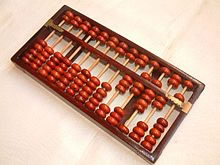
|
||
|
Blaise PASCAL (1623-1662)
|
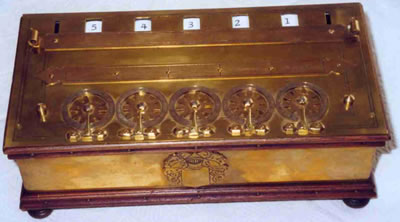 A pascaline signed by Pascal in 1652, visible at the Museum of Arts and Crafts in Paris.
A pascaline signed by Pascal in 1652, visible at the Museum of Arts and Crafts in Paris.
|
||
|
Gottfried Wihelm LEIBNIZ (1646-1716)
|
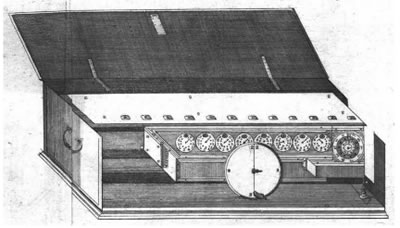
|
||
|
Willgodt Theophil ODHNER (1845 - 1905)
|
 A luxury mechanical calculator presented to Swedish king Gustaf V by Wilgodt Odhner. TM22900. Photo:Archive of National Museum of Science and Technology.
A luxury mechanical calculator presented to Swedish king Gustaf V by Wilgodt Odhner. TM22900. Photo:Archive of National Museum of Science and Technology.
|
||
|
Charles BABBAGE (1791-1871)
|
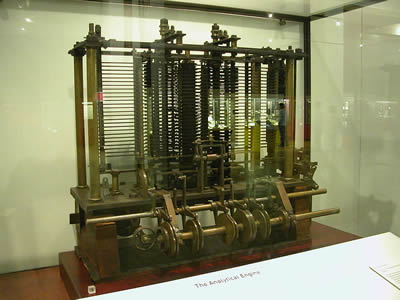 Unfinished prototype (1871) of Babbage's analytical engine, on display in the Science Museum, London.
Unfinished prototype (1871) of Babbage's analytical engine, on display in the Science Museum, London.
 Part of Charles Babbage's difference engine, assembled after his death by his son, Henry Prevost Babbage (1824-1918), using parts found in Charles' laboratory.
Part of Charles Babbage's difference engine, assembled after his death by his son, Henry Prevost Babbage (1824-1918), using parts found in Charles' laboratory.
|
||
|
Alan Turing (1912-1954)
The machine is supplied with a "tape" (the analogue of paper) running through it, and divided into sections (called "squares") each capable of bearing a "symbol". At any moment there is just one square, say the r-th, bearing the symbol T(r) which is "in the machine". We may call this square the "scanned square". The symbol on the scanned square may be called the " scanned symbol". The "scanned symbol" is the only one of which the machine is, so to speak, "directly aware". However, by altering its m-configuration the machine can effectively remember some of the symbols which it has "seen" (scanned) previously. The possible behaviour of the machine at any moment is determined by the m-configuration qn and the scanned symbol T(r). This pair qr, T(r) will be called the '' configuration'': thus the configuration determines the possible behaviour of the machine. In some of the configurations in which the scanned square is blank (i.e. bears no symbol) the machine writes down a new symbol on the scanned square: in other configurations it erases the scanned symbol. The machine may also change the square which is being scanned, but only by shifting it one place to right or left. In addition to any of these operations the m-configuration may be changed.... If at each stage the motion of a machine is completely determined by the configuration, we shall call the machine an "automatic machine" (or a-machine)." Extract of On computable numbers...[Turing 1936] |
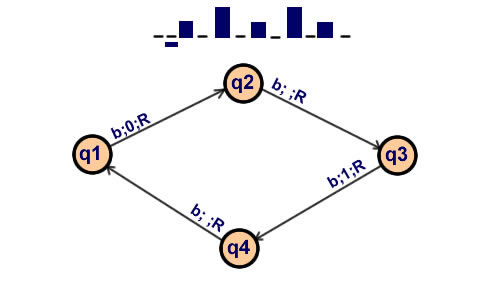 The first a-machine described by Turing in 1936 to compute the sequence "0 1 0 1 0 1 0 1 0 1...".
The first a-machine described by Turing in 1936 to compute the sequence "0 1 0 1 0 1 0 1 0 1...".
|
||
|
Curt Herzstark (1902-1988)
The Curta is a small mechanical calculator produced between 1948 and 1972 by Contina AG Mauren in Liechtenstein. It is composed of a cylindrical body and a small crank making it look like a pepper or coffee grinder. This very small machine makes it possible to carry out very quickly the four basic arithmetic operations and, after learning, other operations such as square roots. View : Curt Herzstark or La calculatrice Curta on Wikipedia. |
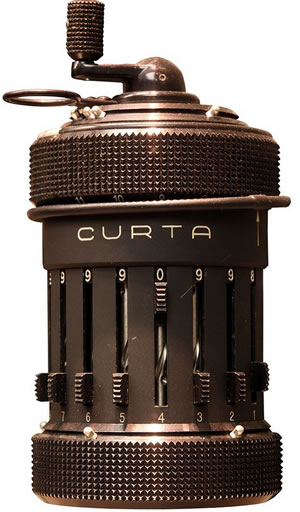
|
||
|
von Neumann (1903-1957)
Changing the program of a fixed-program machine requires re-wiring, re-structuring, or re-designing the machine. With the proposal of the stored-program computer, this changed. Such a computer can store a set of instructions (a program) in memory that details the calculation. The term Von Neumann architecture, also known as the Von Neumann model or the Princeton architecture, derives from a 1945 computer architecture description by the mathematician and physicist John von Neumann and others, First Draft of a Report on the EDVAC. This describes a design architecture for an electronic digital computer with subdivisions of a processing unit consisting of 4 parts:
|
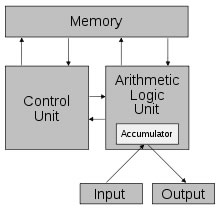 Von Neumann architecture scheme
Von Neumann architecture scheme
|
||